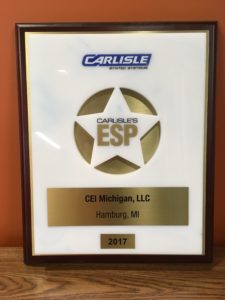Category: Roofer Safety (Page 2 of 2)
 At CEI, safety is built into everything we do. When most of your projects are in challenging working conditions, safety becomes an integral part of your business process. Not only are CEI workers trained and certified in best safety practices, but we discuss the unique safety challenges before every project, have monthly safety meetings with all roofing teams, and even reward our roofers with financial incentives for safe work performance.
At CEI, safety is built into everything we do. When most of your projects are in challenging working conditions, safety becomes an integral part of your business process. Not only are CEI workers trained and certified in best safety practices, but we discuss the unique safety challenges before every project, have monthly safety meetings with all roofing teams, and even reward our roofers with financial incentives for safe work performance.
We incorporate safety into every job site. Every CEI roofing project has a site-specific safety plan that takes the unique challenges into consideration. On each job site, teams gather every day for a safety briefing and review of the plan to assure safe working practices.
Congratulations to CEI Michigan!
CEI Michigan, LLC was recently awarded the Carlisle’s ESP award of 2017. They were given the title of one of the most successful Carlisle contractors in the commercial roofing industry. The award is based on quality and volume of installations of the Carlisle roofing system. CEI is excited about their achievement as a company, as this places them among some of the most elite contractors in the industry.  Thank you to Carlisle’s for recognizing them as one of the highest ranked applicators. Carlisle is always a contractor friendly company and there product is extremely trust worthy. As a company, CEI is always happy to work with them and are honored with this award.
Thank you to Carlisle’s for recognizing them as one of the highest ranked applicators. Carlisle is always a contractor friendly company and there product is extremely trust worthy. As a company, CEI is always happy to work with them and are honored with this award.
2017 Carlisle’s ESP Award
Thank you to the CEI crews who attended today’s Safety meeting. The presentation given today by Joe Fulton, Safety Director at CEI, focused on over all crane safety, the new crane standards and certifying employees for rigging and signaling. MIOSHA establishes and supplies much of the regular monthly safety information that CEI presents to the crew employees. “It was a good class with good discussion and participation.” says Fulton. Great Job, everyone and Be safe out there!

Where to look: Protection from the Top: The Importance of Commercial Roof Cover Maintenance and Repair
The roof is a commercial building’s first line of defense from natural hazards
such as wind, rain, fire, hail, ice, snow, and extreme heat. It is also the most
vulnerable part of your building. Every day, your roof is exposed to weather and
other elements that may contribute to decay and deterioration, increasing the
risk of damage to the roof itself and the contents below it. click
here.
REMOVING ICE DAMS
IBHS does not recommend chipping or breaking ice dams due to the damage that can be inflicted on the roof. If you are not physically capable of going onto the roof or are unable to easily reach the roof, consult a roofing professional.
For low slope roofs or flat roofs:
- Removing the snow will remove the source of a potential ice dam.
- Use a heavy duty push broom with stiff bristles to brush off the snow on low slope or flat roofs.
- A shovel or snow blower should not be used since they may tear up the roof cover system.
For steep slope roofs:
- Removing the snow will remove the source of a potential ice dam.
- A roof rake may be used for most single story buildings while remaining on the ground to pull snow down the roof slope.
- Do not pull snow back against the slope or sideways since the snow may get underneath the cover and can break shingles.
|
|


